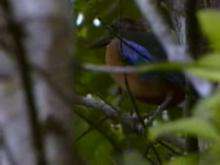Mangrove pitta
| Mangrove pitta | |
|---|---|
%2C_Singapore_Botanic_Gardens_-_20140303.jpg) | |
| Mangrove pitta at Botanic Garden of Singapore | |
| Scientific classification | |
| Kingdom: | Animalia |
| Phylum: | Chordata |
| Class: | Aves |
| Order: | Passeriformes |
| Family: | Pittidae |
| Genus: | Pitta |
| Species: | P. megarhyncha |
| Binomial name | |
| Pitta megarhyncha Schlegel, 1863 | |
The mangrove pitta (Pitta megarhyncha) is a species of passerine bird in the Pittidae family native to Southeast Asia and South Asia. It is part of a superspecies where it is placed with the Indian pitta, the fairy pitta and the blue-winged pitta but has no recognized subspecies. A colourful bird, it has a black head with brown crown, white throat, greenish upper parts, buff underparts and reddish vent area. Its range extends from India to Malaysia and Indonesia. It is found in mangrove and nipa palm forests where it feeds on crustaceans, mollusks and insects. Its call, sometimes rendered as wieuw-wieuw, is sung from a high perch on a mangrove tree.
Taxonomy
The mangrove pitta was first described by German ornithologist Hermann Schlegel in 1863.[1] Its species name is derived from the Ancient Greek words mega- "large", and rhynchos "beak". It forms a superspecies with the Indian pitta (P. brachyura), fairy pitta (P. nympha) and blue-winged pitta (P. moluccensis). Alternate common names include: Larger blue-winged/Malay pitta, Brève des palétuviers (in French), Große Blauflügelpitta (in German), and Pita de Manglar (in Spanish).[2] There are no recognized subspecies.[3]
Description

Measuring 180 to 210 mm (7.1–8.3 in) in length, the mangrove pitta has a black head with a buff-coloured crown, white chin and buff underparts. The shoulders and mantle are greenish and the vent is reddish. Juveniles have similar patterned plumage but are duller. It resembles the blue-winged pitta but can be distinguished by its much heavier bill.[4] Its call, transcribed as wieuw-wieuw has been noted to be "more slurred" than the blue-winged pitta.[4]
Distribution and habitat
The mangrove pitta is native to the countries of: Bangladesh, India, Indonesia, Malaysia, Myanmar, Singapore, and Thailand (primarily the west coast of the southern Thai peninsula).[5][1][6] Its natural habitat is specialised and restriction to subtropical or tropical mangrove forests and Nipa palm stands.[7] It is threatened by habitat loss. Its diet consists of crustaceans, mollusks and terrestrial insects.[5][1][7]
Behaviour
While all pittas are noted for being difficult to study and spot in the wild, the mangrove pitta is one of the easier ones to spot as it sits high up in mangrove trees and calls.[6] A tape recording of its call will often bring it forth.[8] It tends to be vocal while brooding but quiet at other times.[7]
References
- 1 2 3 4 BirdLife International (2012). "Pitta megarhyncha". IUCN Red List of Threatened Species. Version 2014.3. International Union for Conservation of Nature. Retrieved 17 December 2014.
- ↑ "Mangrove Pitta (Pitta megarhyncha)". Internet Bird Collection. Retrieved 4 June 2011.
- ↑ "Species overview :: Mangrove Pitta (Pitta megarhyncha)". Xeno-Canto Asia. Retrieved 4 June 2011.
- 1 2 Robson, Craig (2005). New Holland field guide to the birds of South-East Asia. Kenthurst, New South Wales: New Holland Publishers. p. 76. ISBN 1-84330-746-4. Retrieved 4 June 2011.
- 1 2 "Mangrove Pitta Pitta megarhyncha". BirdLife International. Retrieved 4 June 2011.
- 1 2 "Pittas of Thailand". Thai Birding. Retrieved 4 June 2011.
- 1 2 3 Lok, A. F. S. L.; K. T. N. Khor; K. C. Lim; R. Subaraj (1 April 2009). "Pittas (Pittidae) of Singapore" (PDF). Nature In Singapore. National University of Singapore. 2 (2): 155–165.
- ↑ Strange, Morten (2000). Photographic Guide to the Birds of Southeast Asia. Singapore: Periplus. p. 219. ISBN 962-593-403-0.
External links
| Wikimedia Commons has media related to Pitta megarhyncha. |
| Wikispecies has information related to: Pitta megarhyncha |
